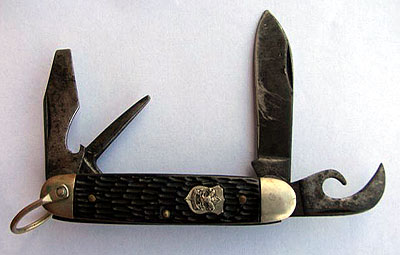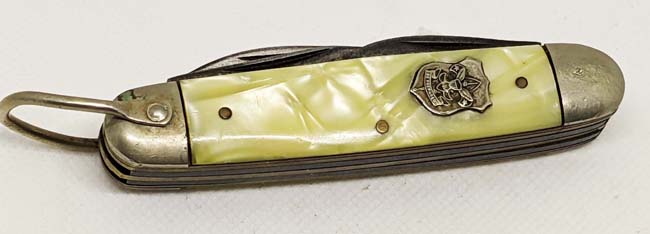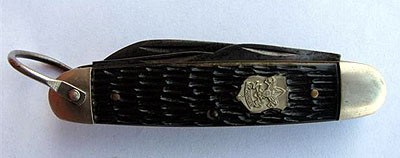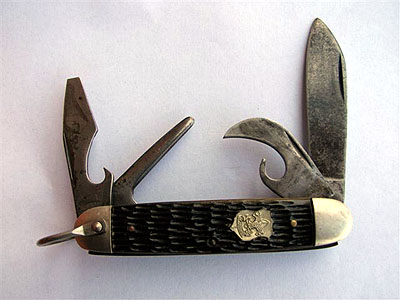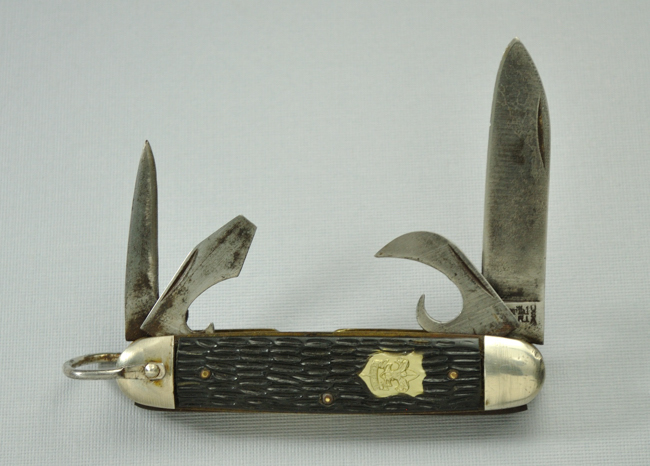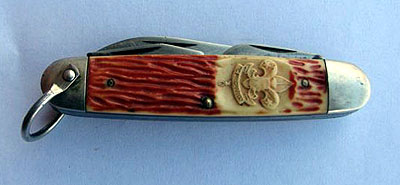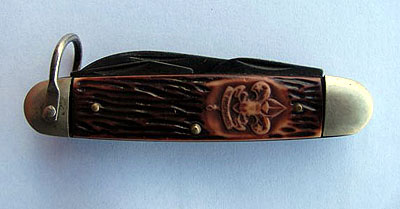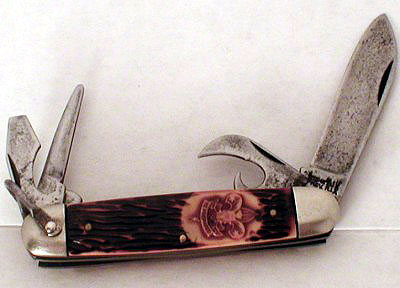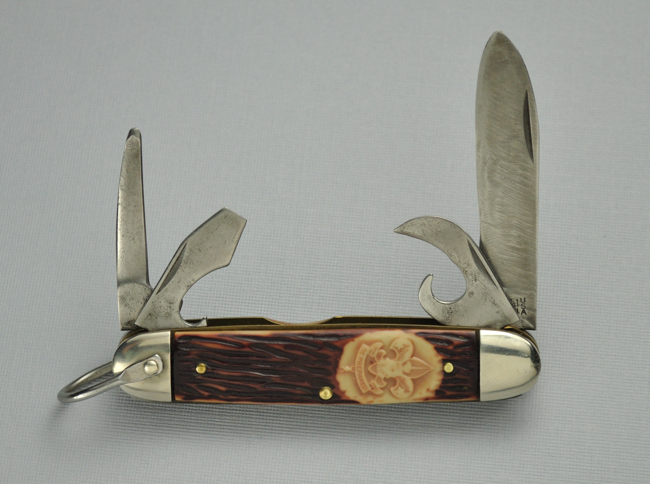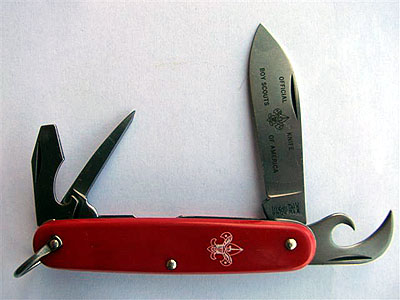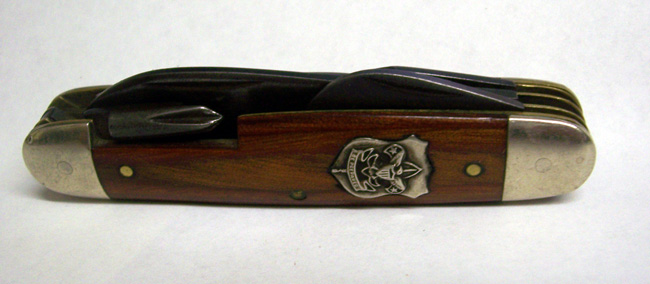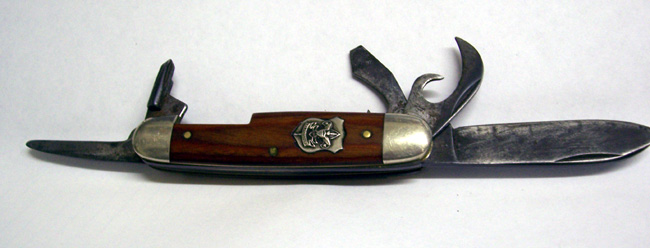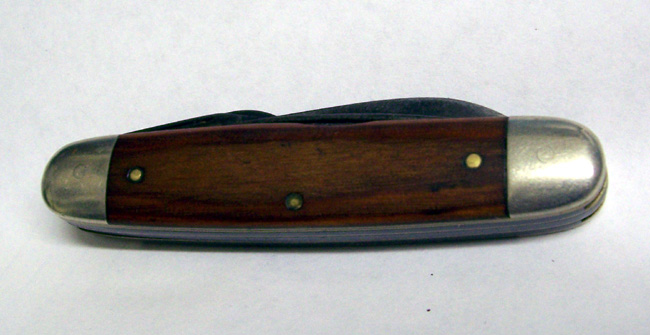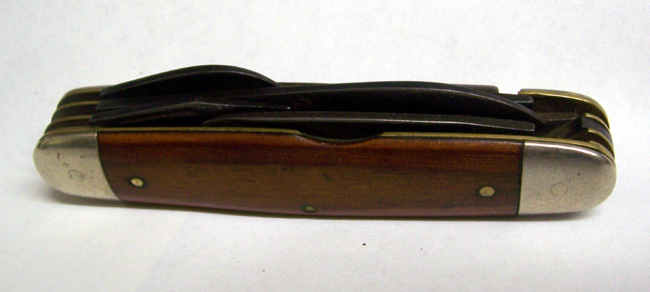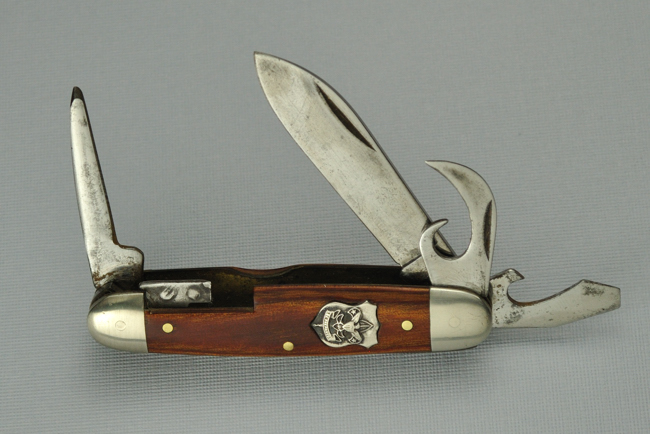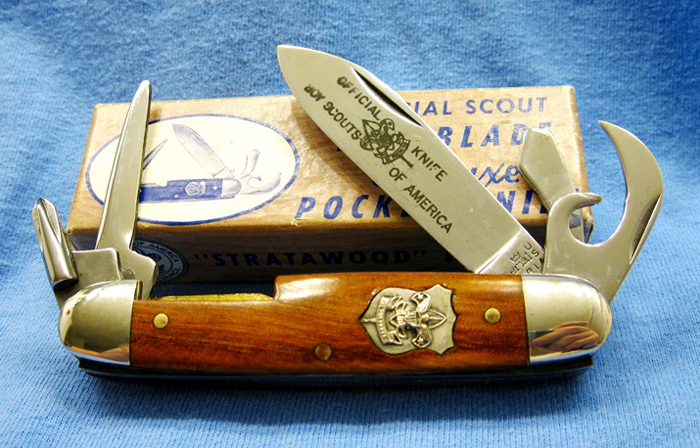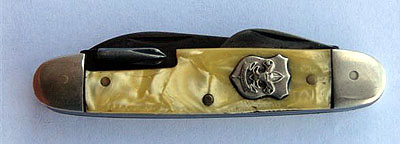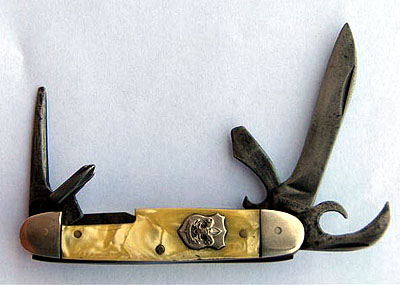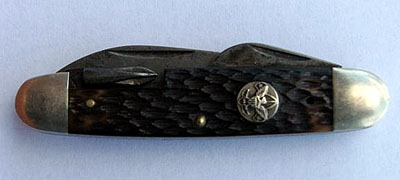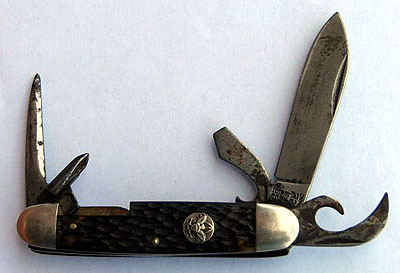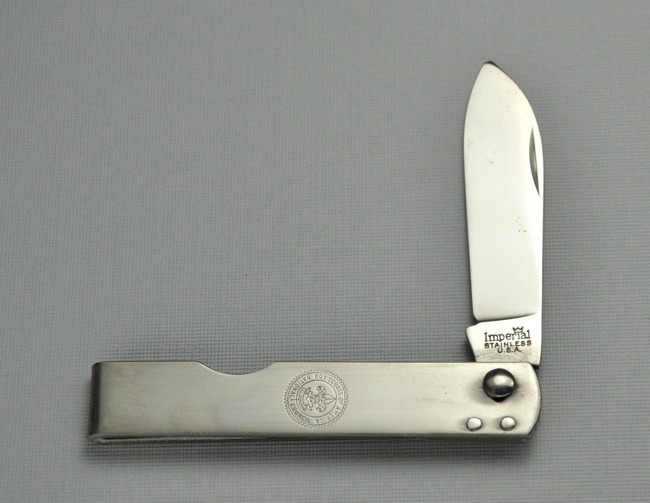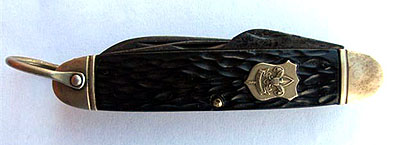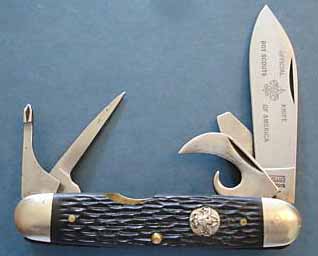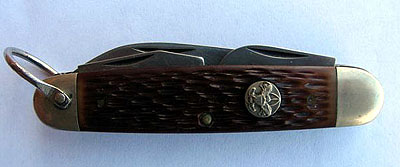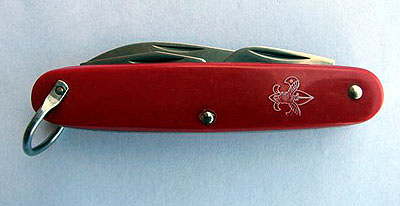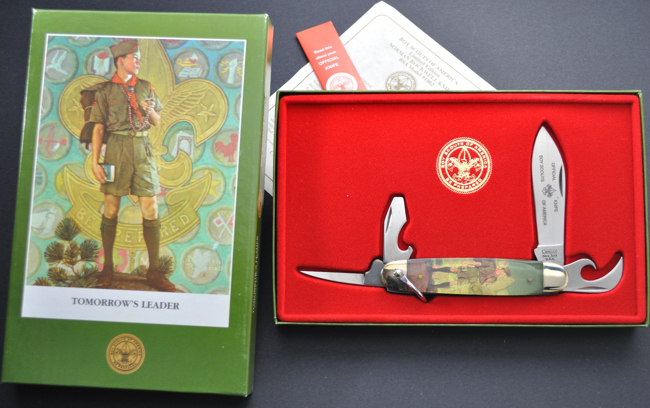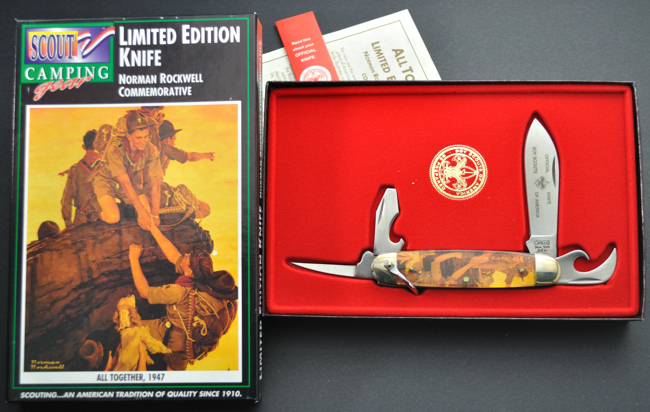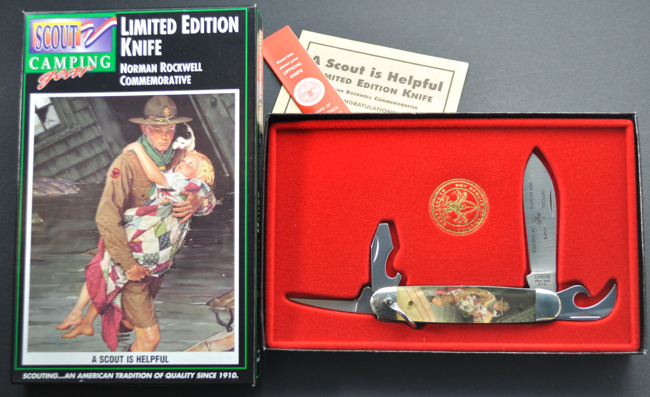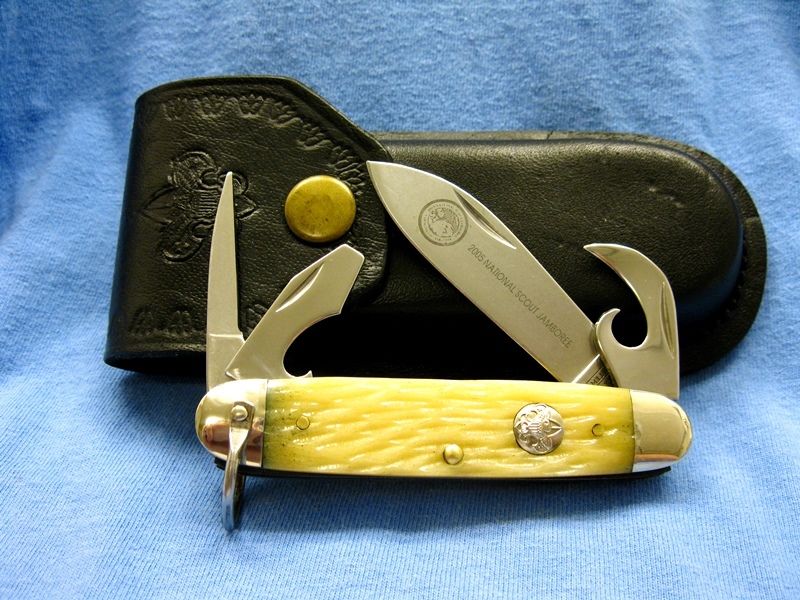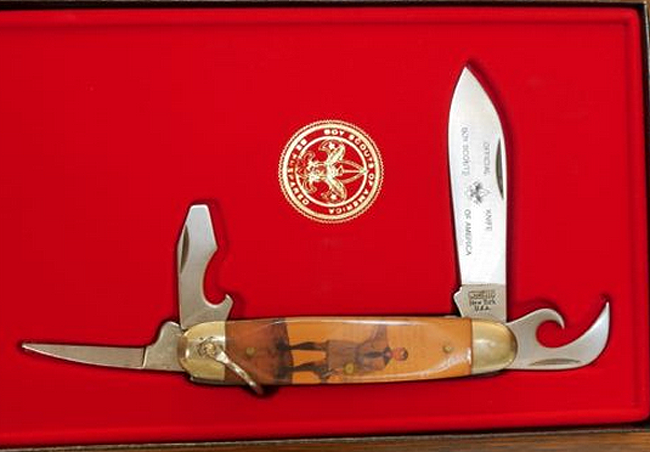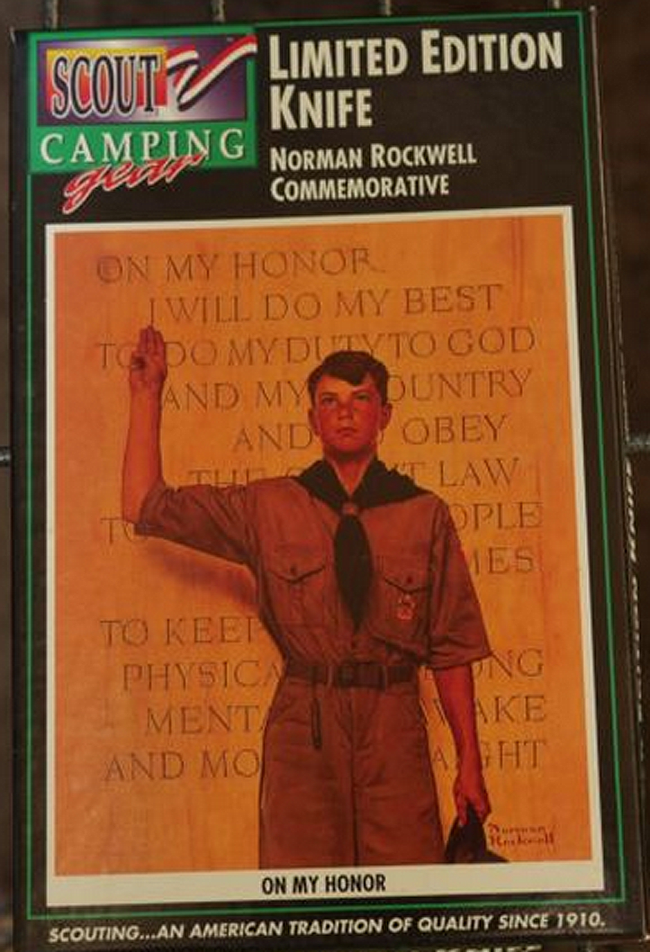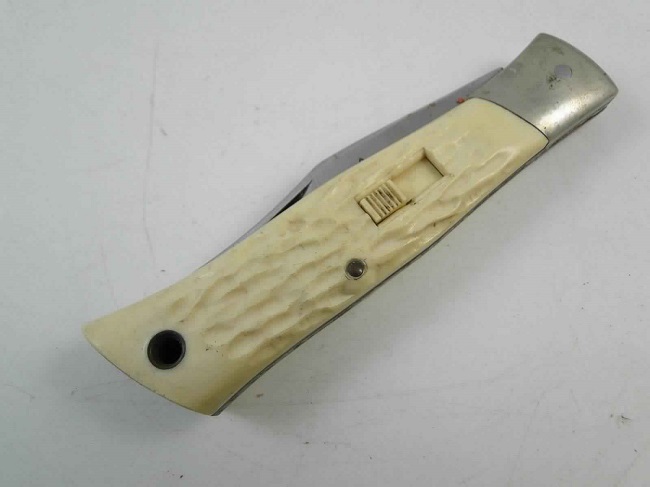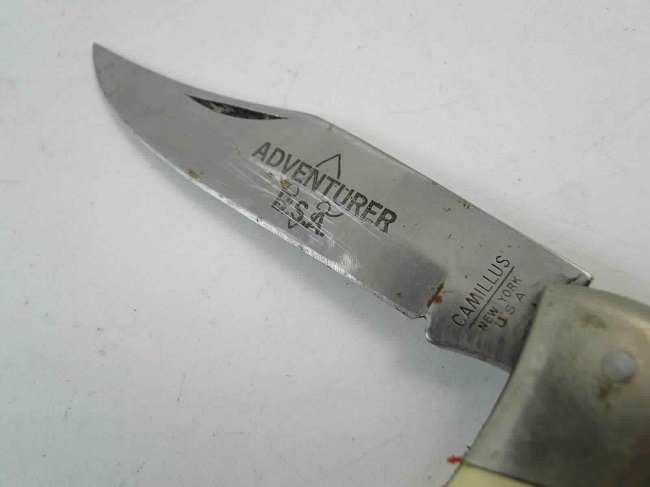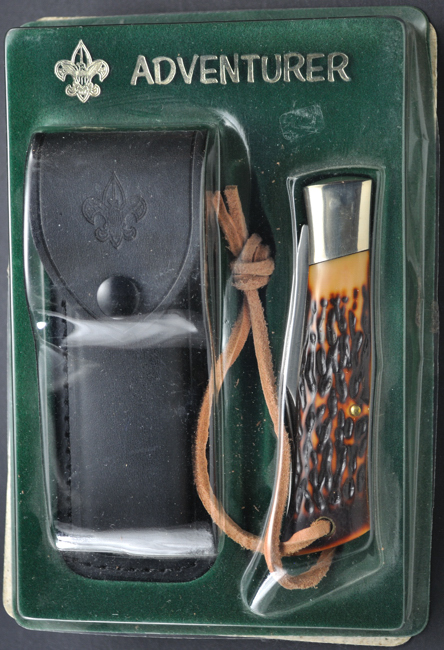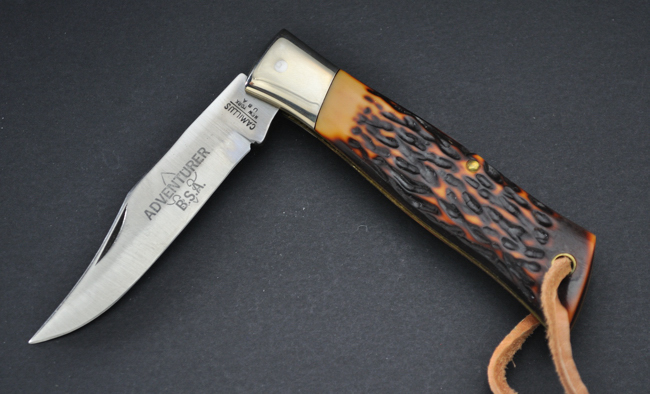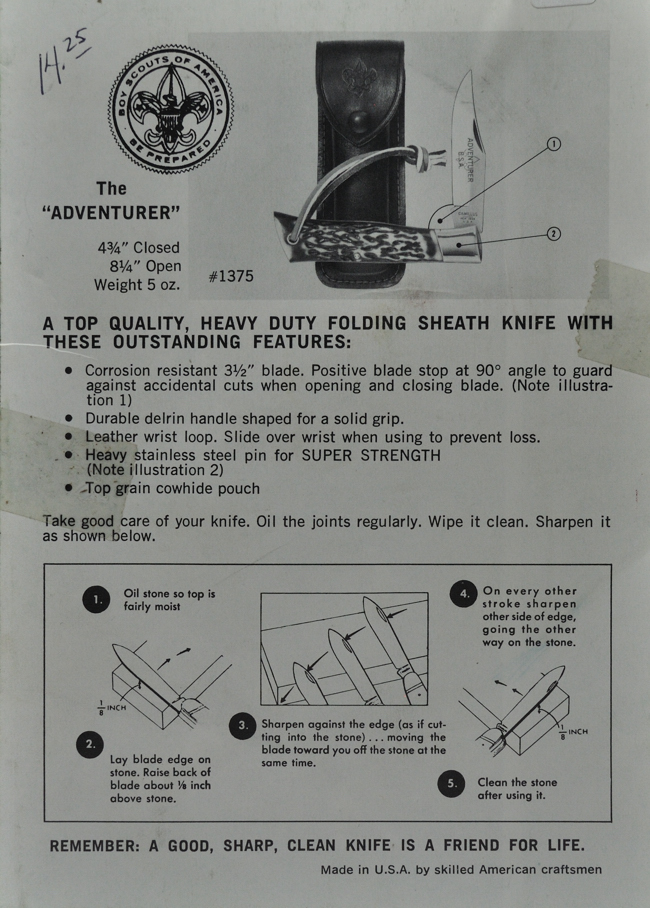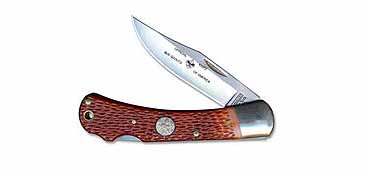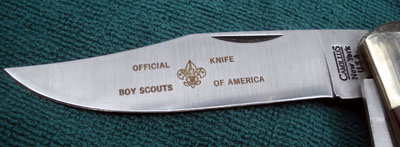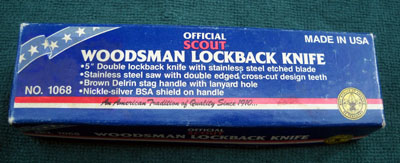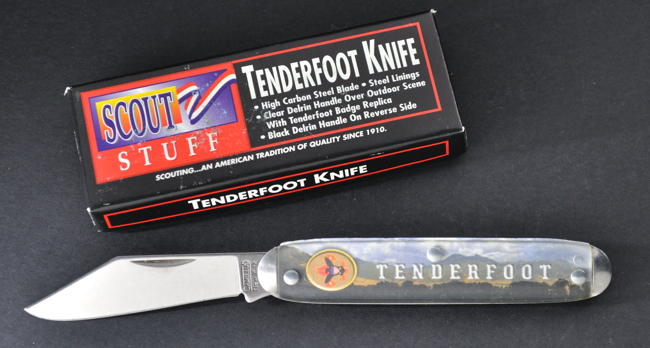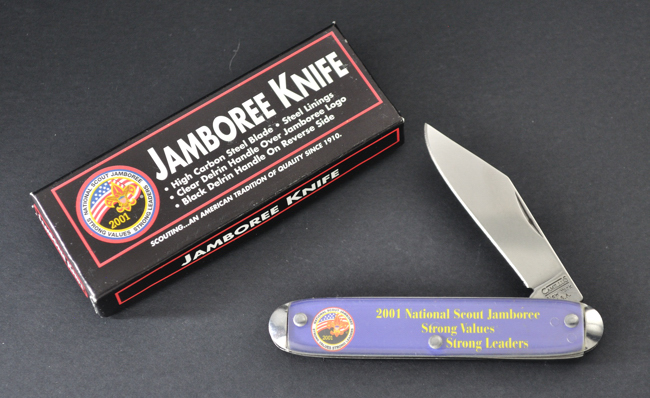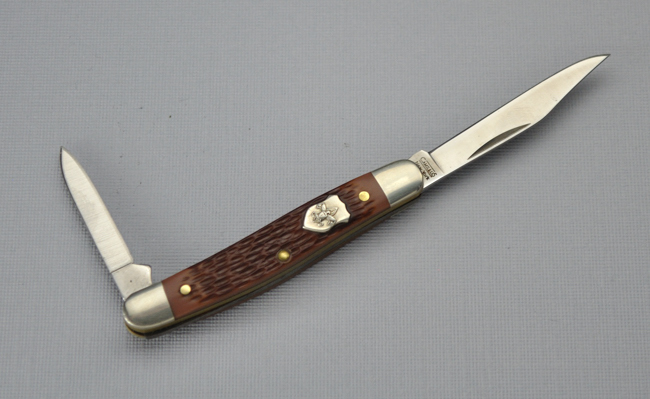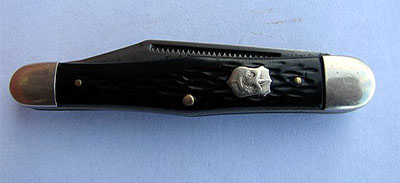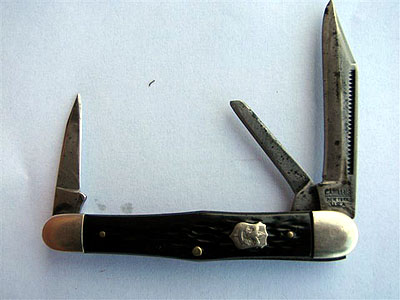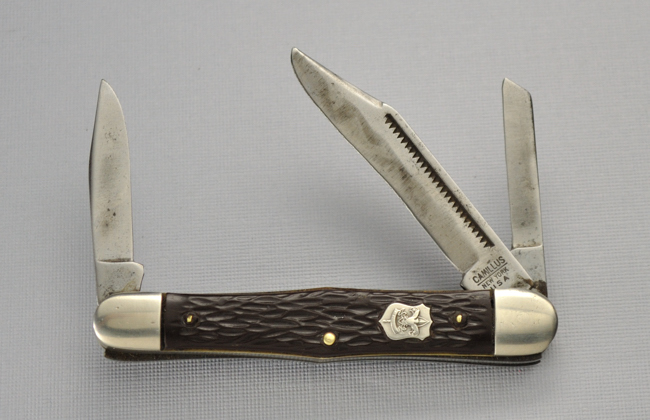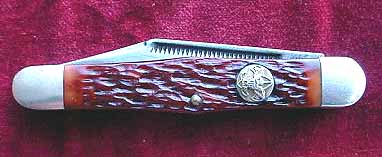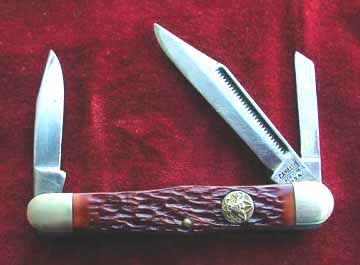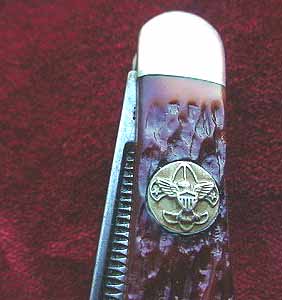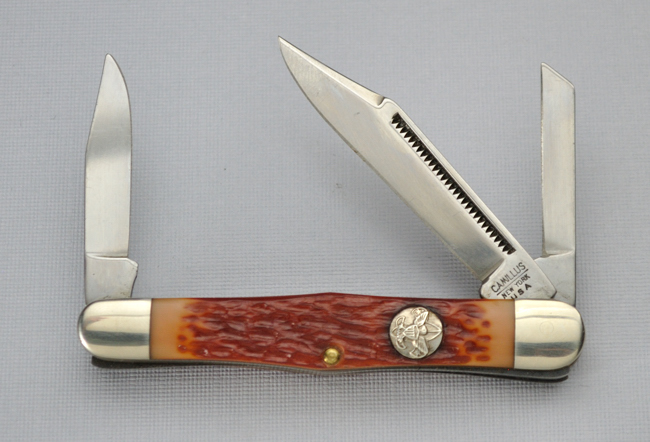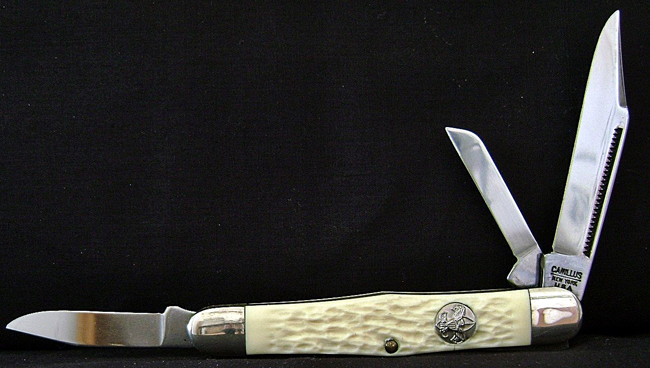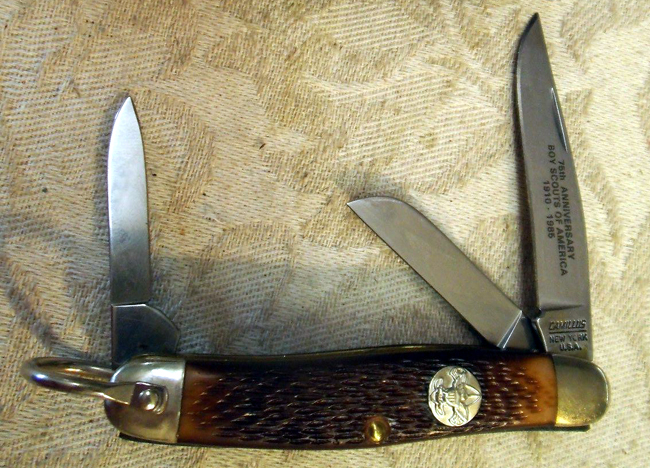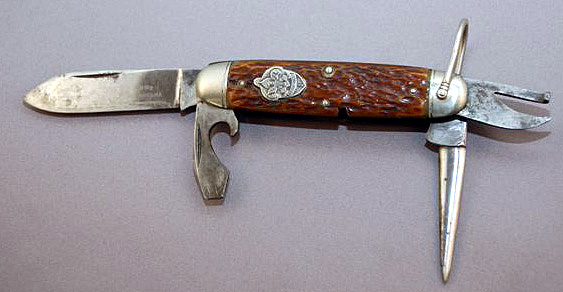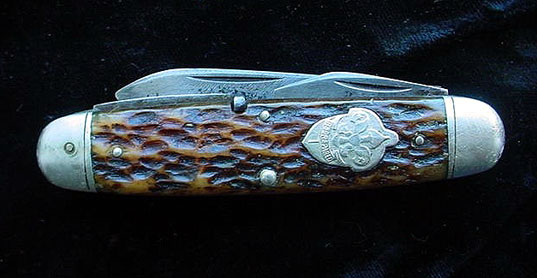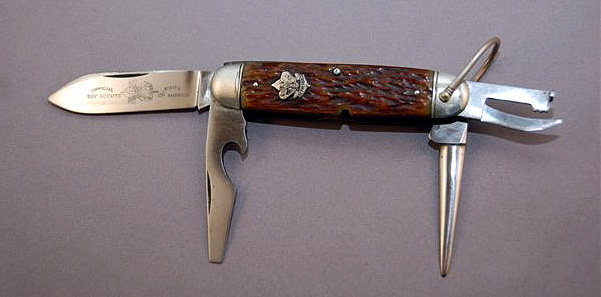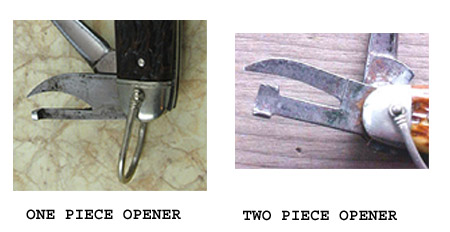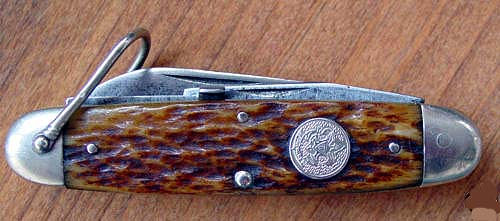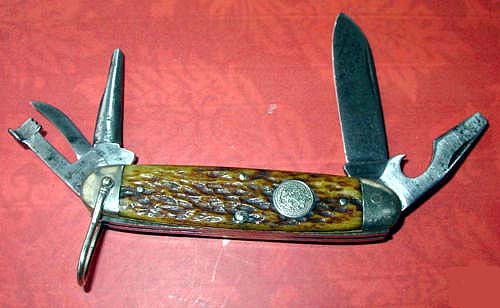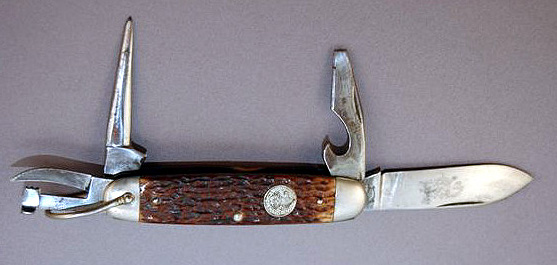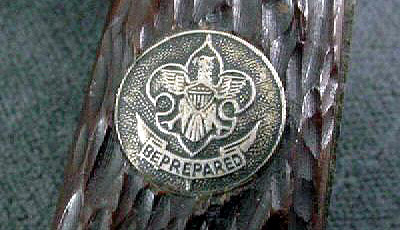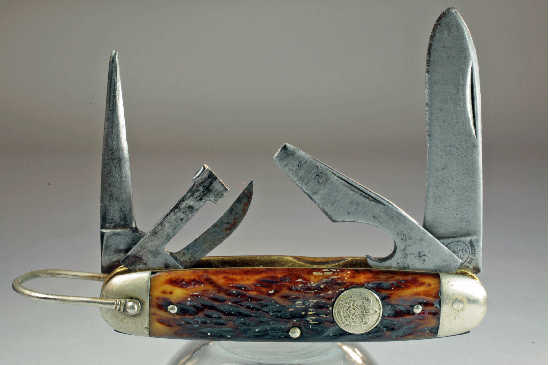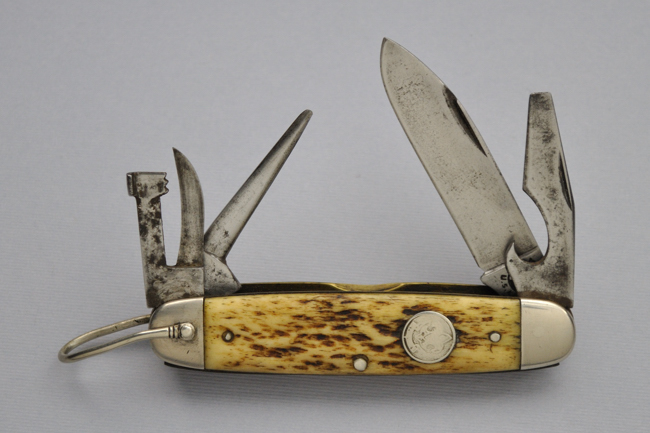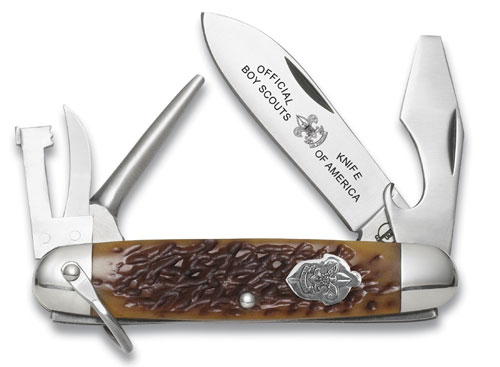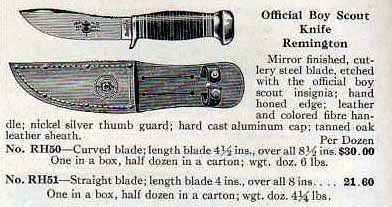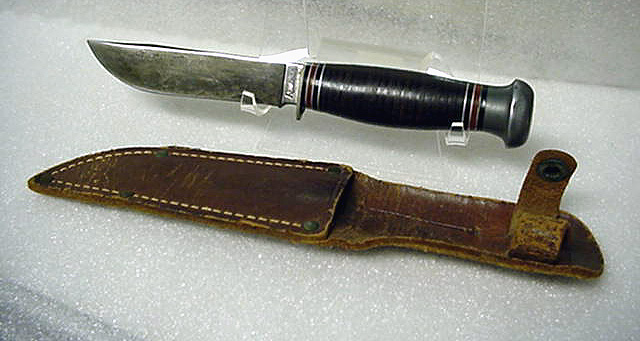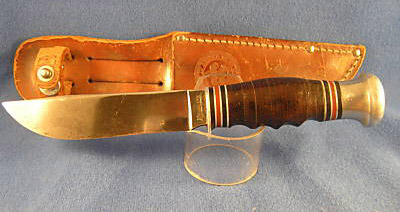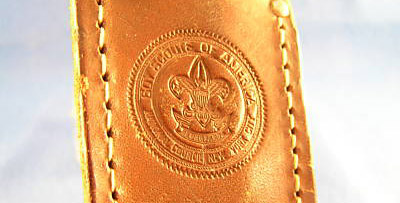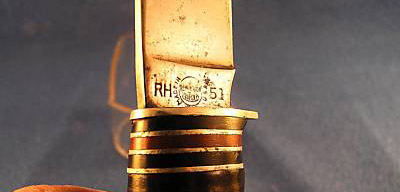Imperial
| Imperial Knife Associated Co. was founded in 1947, as a joint effort between Ulster and Schrade. They were headquartered in Providence, Rhode Island. |
|
IMPC4A, BSA # 1996. This is the classic BSA #1996 camp knife, with four blades: main , can opener, cap lifter/flat blade combo, and awl. The screwdriver blade was longer than later #1996 models, and is longer than the awl. Black, jigged handles, shield shaped BSA shield on main blade end, permanent shackle on end opposite the main blade. Smooth bolsters. Closed length 3 3/4". Manufactured 1949-1955. MPC4A: The first Imperial Boy Scout knife. (Courtesy Phil Stevens)
IMPC4A: The flat blade screwdriver is longer than the awl in this version. (Courtesy Phil Stevens)
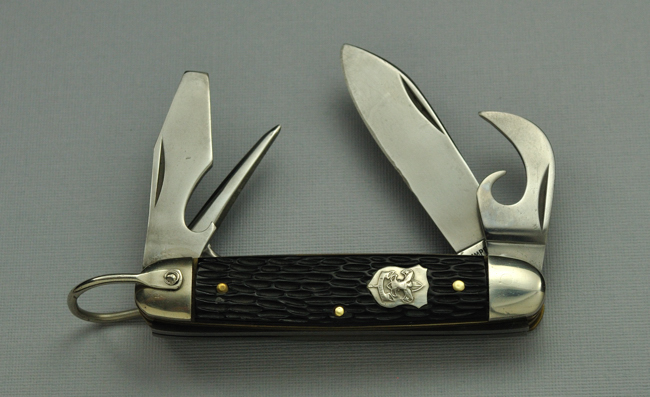 IMPC4A: Slight shrinkage of the handle indicate the scales are not bone.
(Knife courtesy of New Mexico Scouting Museum. Photo by Bob Wick.) |
|
IMPC4B, BSA #1052. Same as IMPC4A, but with white pearl handles, and a change of BSA model number.
IMPC4B: White pearl scales. (Courtesy Allen McBroom)
|
|
IMPC4C, BSA # 1996. Same as IMPC4A, but with a plastic shield. Manufactured 1955-1958. Thomas Linton has noticed a difference of thickness between the C and D versions. "Just handled both the 4C and your 4D at the same time. Turns out the 4C is 21/32" thick and the 4D is only 35/64" thick. Very noticeable. Not too surprising, that is became the tools in the 4C are much thicker."
IMPC4C: Plastic shield with clear overlay. (Courtesy Phil Stevens)
IMPC4C: Another example of the classic BSA #1996. (Courtesy Phil Stevens) |
|
IMPC4D, BSA # 1996. Similar to the IMPC4C, but with plastic shield and short screwdriver, and the D is thinner than the C. The screwdriver is shorter than the awl. Made 1958-1962. Thomas Linton has noticed a difference of thickness between the C and D versions. "Just handled both the 4C and your 4D at the same time. Turns out the 4C is 21/32" thick and the 4D is only 35/64" thick. Very noticeable. Not too surprising, that is became the tools in the 4C are much thicker."
IMPC4D |
|
IMPC4E, BSA # 1996. Four blades: main, can opener, cap lifter/flat blade combo, awl. The screwdriver is shorter than the awl. BSA logo (First Class badge) is relief molded into the handle. Brown or reddish-brown handles. The handles on this model aged differently, resulting today in many different shades of handles and logos. Manufactured 1958-1962.
IMPC4E: These are found in different shades of red and brown. (Courtesy Phil Stevens)
IMPC4E: Same model as the one above, but with darker shield, handles. (Courtesy Phil Stevens)
IMPC4E: Personal Scout knife, purchased new in 1961 in Ft. Worth, TX. (Courtesy Johnnie Fain)
IMPC4E: Another shade of red and brown.
(Knife courtesy of New Mexico Scouting Museum. Photo by Bob Wick.)
|
| IMPC4F, BSA # 1996. Four blades: main, can opener, cap lifter/flat blade combo, awl. The screwdriver is shorter than the awl. Brown jigged handles, round shield. Manufactured 1963-1965. |
|
IMPC4G, BSA #1045. Four blade camp knife: main, can opener, cap lifter/flat blade combo, awl. The screwdriver is shorter than the awl. 3 3/4" closed. Smooth, black plastic handles, Lanyard ring on end opposite the shield. BSA logo in white on main blade end. Manufactured 1973-1979.
Rugged but sturdy version of the IMPC4G (Allen McBroom) |
|
IMPC4H, BSA # 1045. Same as IMPC4G, but with white handles. Manufactured 1980-1981.
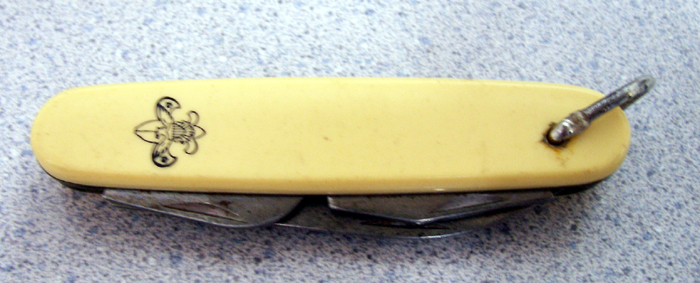 Clean example of the IMPC4G (Allen McBroom)
|
|
IMPC4I, BSA #1045. Same as IMPC4G, but with brown handles. Manufactured 1982-1985.
 Brown handled IMPC4I (Allen McBroom)
|
|
IMPC4J, BSA #1045. Same as IMPC4G, but with red handles. Manufactured 1986-2007.
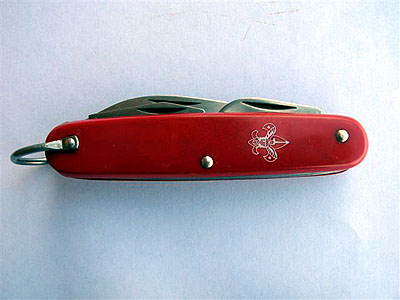
IMPC4J: Red, smooth plastic nadles on a camp knife. (Courtesy Phil Stevens)
IMPC4J: A nice, clean example of this version of the classic BSA camp knife. (Courtesy Phil Stevens)
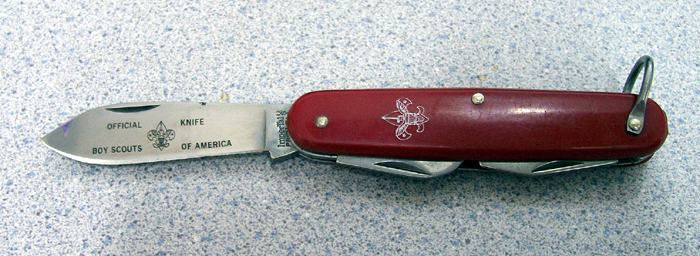 Another clean example of the red Imperial known as the IMPC4J (Courtesy Allen McBroom)
|
|
IMPC5A, BSA #1046. Shorter than usual knife, only 3 1/2" closed. Natural rosewood handles, five blades: main can opener, cap lifter/flat blade combo, awl, Phillips screwdriver. No lanyard ring.The Phillips blade drops into a handle notch on the shield side. Manufactured 1952-1962. IMPC5A: Rosewood handles and a short, five blade knife. Totally cool, totally utilitarian. (Courtesy Allen McBroom)
IMPC5A: Very nice example of this rosewood handled knife. (Knife courtesy of New Mexico Scouting Museum. Photo by Bob Wick.) IMPC5A: Beautiful example with box. (Courtesy of Ron Fish)
|
|
IMPC5B, BSA #1043. Same as IMPC5A, but with white pearl handles. Manufactured dates NA.
IMPC5B: White pearl handles make a nifty appearance. (Courtesy Phil Stevens)
IMPC5B: The nubby Phillips drops into a handle notch. (Courtesy Phil Stevens)
|
|
IMPC5C, BSA #1046. Five blades: main, can opener, cap lifter/short flat blade combo, awl, short Phillips. Brown stag-appearing jigged handles, round shield on main blade end, 3 3/4" long. No lanyard ring. Manufactured 1963 - NA.
IMPC5C: Five blade Imperial camp knife. (Courtesy Phil Stevens)
IMPC5C: The BSA Imperial "jack of all trades". (Courtesy Phil Stevens)
|
| IMPC5D, BSA # NA. Same as IMPC5C, but with smooth plastic handles. Manufactured 1962-1963. |
|
IMPN1A, BSA# NA. Stainless steel handles and single blade. National Council logo on handles. Not found in Holbrook or Kerr guides.
IMPN1A: Stainless, single blade National Council knife. (Knife courtesy of New Mexico Scouting Museum. Photo by Bob Wick.) |
| IMPW2A, BSA #1066. Two blade knife, both blades hinged on same end. White handles, 2 7/8" long. Etching on main blade. The tang is stamped "Frontier" which was an Imperial mark. No shield. Manufactured 1982-1985. |
| IMPW2B, BSA # 1066 Same as IMPW2A, but with blades on same end, and no etching. Manufactured 1981. |
BSA Knives Online Collection
(This is a "work in progress". Please add to the collection!)
Boy Scout knives have been around almost as long as the BSA itself. The Boy Scouts of America was founded in 1910, and one year later, the first official BSA knife appeared on the landscape.
How to Contribute to the Online Collection
To make a contribution to this site (and, don't be shy... contributions are more than welcome!), there are two easy ways.
Camillus
|
In 1902, Adolf Kastor, a German immigrant, purchased small knife factory in Camillus, New York, and began supplying domestically produced knives to the nation. The Camillus plant became famous for its military knives and pocket knives. In 1946, Camillus Cutlery began making official knives for the BSA. They produced quality knives for the Scouts until 2007, when the factory closed its door for the last time. Here is an outstanding history of Camillus, written by Mr. Dexter Ewing. Camillus also, at times, produced BSA knives that were marked as Imperial and Schrade Walden. |
|
CAMC4A, BSA #1996. This is a camp style knife. The #1996 is one of the standard BSA models, produced by several different companies. On the bail end, it has two blades, one a combination flat bade screwdriver and bottle opener, the other an awl(leather punch). The other end has the main blade, and a two-piece can opener. The shield is shield shaped, and made of raised silver metal. The shield has the First Class badge on it. The handles are black. The bail is permanently attached. Each bolster has a single line stamped into it. Carbon steel blades. This version was manufactured from 1946-1949.
CAMC4A: Note lined bolsters, black handles. (Courtesy Phil Stevens)
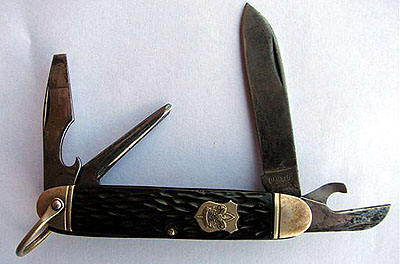 CAMC4A: This, the 1996, was the most popular BSA model in history. (Courtesy Phil Stevens)
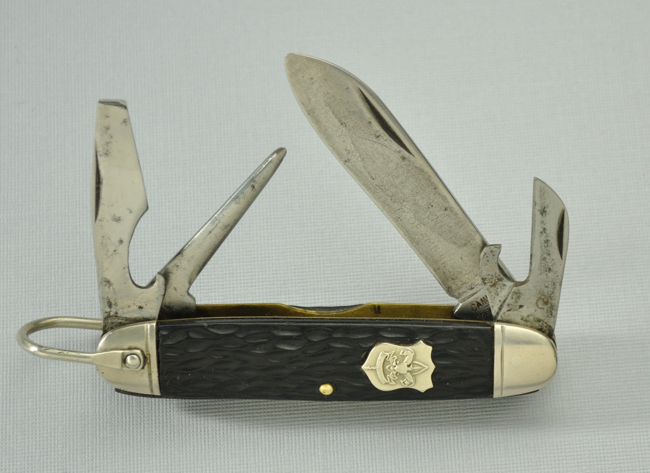 CAMC4A (Knife courtesy of New Mexico Scouting Museum. Photo by Bob Wick.)
|
| CAMC4B, BSA # 1052. This is the same as the CAMC4A, but with white pearl handles instead of the black handles. Manufactured 1949-1953. |
| CAMC4C, BSA #1996. This is the same knife as the CAMC4A, but with one variation. This one has a one-piece can opener. Produced 1950-1953. |
| CAMC4D, BSA #1996. This version is the same as the CAMC4A, except the bail is removeable, and the screwdriver blade is shorter. The main blade is etched "Official Knife, Boy Scouts of America", and has the BSA eagle and fleur-de-lis in the center. Manufacture began in 1954. |
| CAMC5A, BSA #1046, Camillus #BSA046. This is the first major change in Camillus Scout knives. The shield is now round, with the BSA eagle on it. The bolsters are smooth and unlined, and there is no bail. handles are black, jigged Delrin. The shield end has three blades, the main blade (etched same as the CAMC4D), a one-piece can opener, and a combination flat-blade screwdriver and bottle opener. The other end has two blades, an awl (leather punch), and a short Phillips screwdriver. The Phillips blade drops into a rectangular notch in the shield side of the knife. 3 5/8" closed, 8" open, main blade is a 2 1/2" stainless spear. Manufactured 1986-1991. |
| CAMC5B, BSA #1046, Camillus #BSA046.This knife is very similar to the CAMC5A, but with some significant differences. The blades are stainless steel instead of carbon steel as with the CAMC5A. The Phillips blade is longer and skinnier.
The awl has a broader base. The rectangular notch for the Phillips blade is gone, and a semi-circular nail notch has been added in its place. 1998 suggested retail was $33.95. Manufactured from 1992-2007.
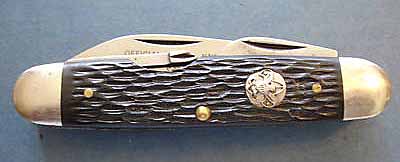 CAMC5B: Notice the semi-circular nail notch for lifting the Phillips blade.
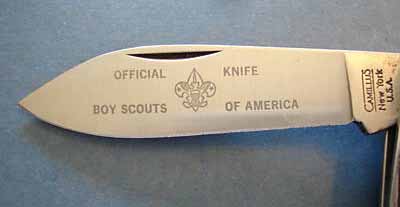 CAMC5B: Nice shot of the etched blade, and the Camillus tang stamp.
|
| CAMC4E, BSA #1996. The #1996 has so many variations, it's amazing the BSA kept assigning the same model number to so many different knives. The CAMC4E is a camp knife. The handles are black, the bolsters are smooth and unlined. The bail is permanently attached. It has the round shield with BSA eagle and fleur-de-lis. The stainless steel main blade is etched "Official Knife, Boy Scouts of America", and has the BSA eagle and fleur-de-lis in the center. 3 3/4" length closed, 8" open, main blade is a 2 1/2" stainless spear blade. Has nickel silver bolsters. 1998 suggested retail was $29.49. Offered 1989-2007. |
|
CAMC4F, BSA #1996, Camillus #BSA0008. Same as the CAMC4E, but with brown jigged Delrin handles. Camillus referred to this as a "four blade camp knife". Production data: Production card numbered A5779-A-06. The spear was 3 3/4" x 095, and actually made by Ulster. The short screwdriver and can opener were purchased from another source. The belt punch was made in house, and was 2 1/2" x 072. All were made from 1095 steel. The handles were identifed as "Br Stag BSA emblem Delrin". Clevis was nickel plated. 2007 retail was $41.75. Manufactured 1985 - 2007.
CAMC4F: Note brown jigged handles, smooth bolsters. (Courtesy Phil Stevens)
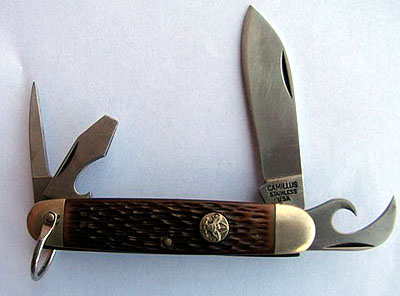 CAMC4F: The original blade etching has worn off on this specimen. (Courtesy Phil Stevens)
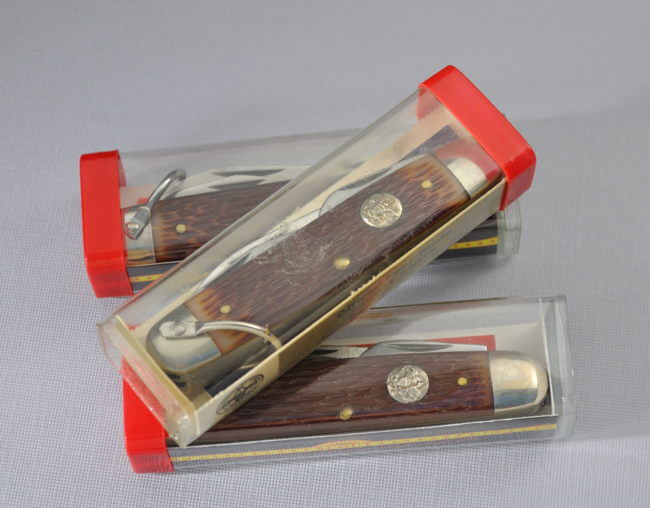 CAMC4F (Knife courtesy of New Mexico Scouting Museum. Photo by Bob Wick.)
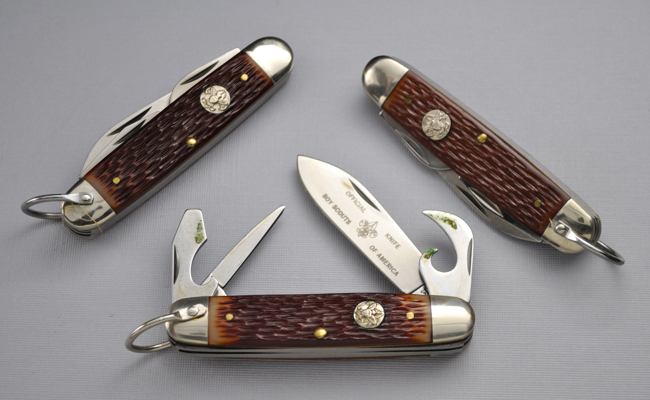 CAMC4F (Knife courtesy of New Mexico Scouting Museum. Photo by Bob Wick.)
|
|
CAMC4G, BSA #NA. The CAMC4G is a departure from the traditional camp knife, as this one has smooth red plastic handles. Four blades, a main clip, awl, combo bottle opener and flat-blade screwdriver, and can opener, permanent lanyard ring, and a white BSA logo on the main blade end of the red handle. Main blade is fully etched. Manufactured NA - 2007.
CAMC4G: An unusual camp knife with red plastic handles. (Courtesy Phil Stevens)
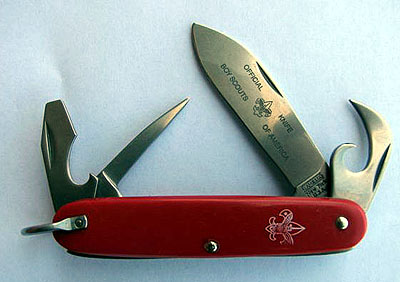 CAMC4G: A nice specimen of tbis knife, with full blade etch and handle logo. (Courtesy Phil Stevens)
|
|
CAMC4H, BSA# 1002 Norman Rockwell Commemorative, "Tomorrow's Leader", Limited Edition, in presentation case.
CAMC4H (Knife courtesy of New Mexico Scouting Museum. Photo by Bob Wick |
|
CAMC4I, BSA # Norman Rockwell Commemorative, "All Together, Now", Lmited Edition, in presentation case. Reverse side has the Scout Law on the handle. Manufactured c. 1996. UPC 0730176010649.
CAMC4I (Knife courtesy of New Mexico Scouting Museum. Photo by Bob Wick.)
|
|
CAMC4J, BSA# Norman Rockwell Commemorative, "A Scout Is Helpful", Limited Edition, in presentation case.
CAMC4J (Knife courtesy of New Mexico Scouting Museum. Photo by Bob Wick.) |
|
CAMC4K, BSA# (No Kerr # or Holbrook #) 2005 National Jamboree four blade knife. Main blade, one piece can opener, awl, and cap lifter/flat blade screwdriver. Blade is etched with the 2005 NJ Ft. A.P. Hill logo, and 2005 National Scout Jamboree. Handles are white bone, permanent bail, no lines on bolsters. Leather sheath has Tenderfoot badge on the flap. More information about this knife would be appreciated.
CAMC4K: White bone, four blades, with leather sheath. (Photo courtesy of Ron Fish) |
|
CAMC4L, BSA # 1787 Norman Rockwell Commemorative, "On My Honor", Limited Edition, in presentation case. Manufactured 1999.
CAMC4L: "On My Honor" Commemorative knife in presentation box. (Photos courtesy os Thomas Linton) |
|
CAMC5A, BSA #1046. Black handle, five blade, no bail. |
| CAML1A, BSA # 1371. White handle, gold fleur-de-lis in a translucent blue, oval shield. Lanyard hole in end opposite the hinge. Blade etched "BSA lock back". Blade length 3 5/8". The BSA misspelled the words "Lock Back" on the box, but not on the blade. This may have been an attempt at forming a trademark name for the lock back knife style. Manufactured 1980-1984.
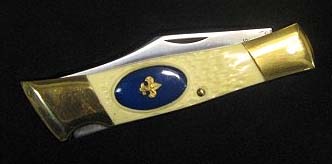 CAML1A: Note blue oval, jigged white handles, and gold fleur-de-lis
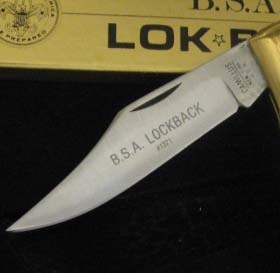 CAML1A: Blade showing etch and BSA #1371 (Source: unknown)
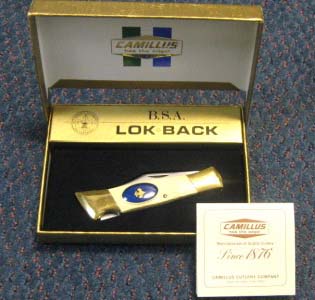 CAML1A: Presentation box and paperwork
|
|
CAML1B, BSA #1372, Kerr #CAM25BR. Lock back knife, white handle, single blade is etched "Adventurer, BSA". Slide switch lock. Blade is 3 5/8" long. Lanyard holblack leather belt holster. Came with leather lanyard and Manufactured 1980-1984. CAML1B, closed position CAML1B, with blade open. Rough specimen, but it gets the idea across. |
| CAML1C, BSA #1065 Single blade lock back, blade 2" long, traditional BSA eagle and fleur-de-lis sheild on end opposite hinge,blade etched "BSA LOCK BACK # 1065". Made !982-1988. |
| CAML1D, BSA # 1370 Similar to CAML1C, with two differences: blade is 3 5/8", and shield is a fleur-de-lis. Manufactured 1985-1987. |
|
CAML1E, BSA #1381 or 1375 Single blade lock back. Jigged Delrin handle, blade 3 5/8", lanyard hole in end opposite hinge, no shield, blade marked "Adventurer BSA". Open length 8.25", closed length 4.75". Weight 5 ounces. Original price $14.25. Made 1985-1988.
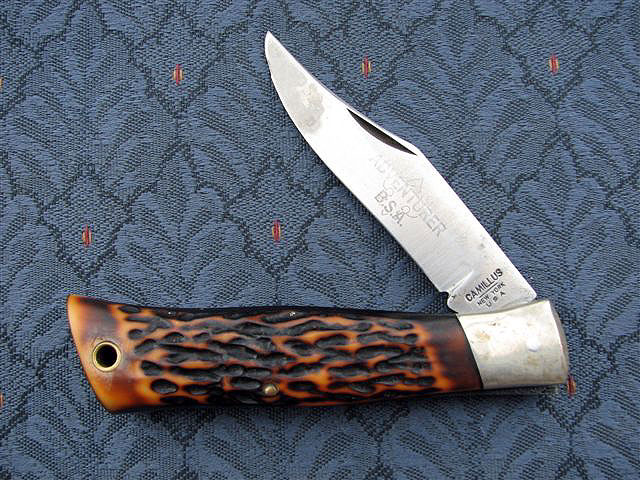 Adventurer Lockback, CAML1E (Photo courtesy Phil Stevens)
CAML1E in original package (Knife courtesy of New Mexico Scouting Museum. Photo by Bob Wick.)
CAML1E: Note leather lanyard, which was original. (Knife courtesy of New Mexico Scouting Museum. Photo by Bob Wick.)
CAML1E: The all-important instruction sheet |
| CAML1F, BSA #1065 Single blade lock back, short blade at only 2". Single bolster at hinge end. Blade etch is "Boy Scouts of America". Shield is traditional BSA eagle and fleur-de-lis on end opposite hinge. Manufactured 1989-1991. |
| CAML1G, BSA #1066Single blade lock back, single bolster on hinge end, blade etched "Official Knife Boy Scouts of America". Has brass tube lanyard hole, traditional BSA eagle and fleur-de-lis shield. 5" length closed. Made 1989-2007.
CAML1G: Single blade Camillus lock back |
|
CAML1H, BSA#
CAML1H (Knife courtesy of New Mexico Scouting Museum. Photo by Bob Wick.) |
CAML2A, BSA #1068, Camillus #CM-BSA068 "Woodsman Double Lockback". Two blade lock back. Main blade is a traditional main blade, etched "Official Knife Boy Scouts of America". Second blade has a saw tooth edge. 3 3/8" high carbon stainless steel clip blade with BSA etch, and a 3 3/8" stainless wood saw. The brown jigged Delrin handle comes with a round coined nickel silver fleur-de-lis shield, a nickel silver bolster, a double lockback, and a lined lanyard hole. Single bolster. The Camillus Boy Scout Woodsman Double Lockback Knife is 5" closed, and has an overall open length of 8 3/4".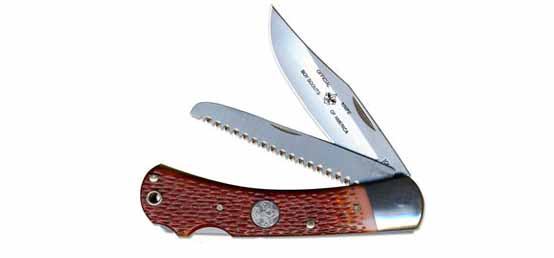 CAML2A: Double Blade "Woodsman" Lock Back
CAML2A: Blade etch and tang stamp (Photo: A. McBroom)
CAML2A: Original Camillus box (Photo: A. McBroom)
|
|
CAMN1A, BSA#
CAMN1A: Tenderfoot penknife. (Knife courtesy of New Mexico Scouting Museum. Photo by Bob Wick.) |
|
CAMN3A, BSA #1995, Camillus # BSA0007. Eagle Scout knife, red, white, and blue Duralens handles. "EAGLE SCOUT" in all capital letters in the white stripe. 2 1/4" closed, 5 1/2" open. Shield is an eagle with raised wings. The three blades are main blade and nail file, on the shield end, and scissors on the other end. Main blade is a high carbon stainless steel pen blade. Has small key ring loop on mainblade end. Packaged in a gift box. Production data: The Camillus production card for this knife was numbered A5799A19. The main blade (spear) wa defined as 2 5/8" X 049, made from 420 stainless. File was 420 stainless, and 2 1/4" x 049. Full linings of 430 stainless, bolster tip 410 stainless. Covering (scales) listed as "Plain 424 Red Eagle Scout". Account of #872, Eagle Scout (1995). Production numbers: Actual production numbers are not complete, but there are factory notes specifying some of the production runs as follows: 10/1986 (First Time) 10,000 pcs; 10/1987 2,500 pcs; 01/1988 4,500 pcs. The production of this knife was prolific, with over 17,000 pieces produced in the first two years. 1998 suggested retail was $29.95, 2007 retail was $41.75. Manufactured 1987-2007. (Data courtesy Tom Williams) |
| CAMN3B, BSA #1998. Green handled "Exploring" knife. Has word "Exploring" down length of handle. The "E" is stylized, and the lower leg extends under the "x", and has a fleur-de-lis. Manufactured 1987-present. |
|
CAMP1A, BSA#
CAMP1A (Knife courtesy of New Mexico Scouting Museum. Photo by Bob Wick.) |
|
CAMW2A, BSA#1900, Kerr #CAM22BR 2.88" long when closed.
CAMW2A (Knife courtesy of New Mexico Scouting Museum. Photo by Bob Wick.) |
|
CAMW3A, BSA #1047. This is the classic three-blade "whittler" style pocket knife. It has the silver-colored, raised metal shield with the First Class badge on it. The handles are black, and secured to the liners by two rivets plus the pivot pin. The main blade has a long nail pull, serrated to double as a match striker. the main blade and the medium blade are on the shield end, and the short blade is on the opposite end. The bolsters are smooth and unlined, and the handles have a swelled center. Produced 1947-1969.
CAMW3A: Black handles, shield shaped BSA shield. (Courtesy Phil Stevens)
CAMW3A: Three blade whittler (Courtesy Phil Stevens)
CAMW3A (Knife courtesy of New Mexico Scouting Museum. Photo by Bob Wick.) |
| CAMW3B, BSA #1047. This is identical to the CAMW3A, but with the addition of a removable bail on the end opposite the shield. Produced 1947-1969. |
| CAMW3C, BSA #1047. Same as the CAMW3B, but with brown handles instead of black handles. Produced 1947-1969. |
| CAMW3D, BSA #1047. Same as CAMW3DC, except shield is plastic. These knives were made by Imperial for Camillus, so the tang is stamped "Imperial Knife Co.". Manufactured 1963-1969. |
| CAMW3E, BSA #1047. Same as CAMW3D, except the shield is now round, with the BSA eagle and fleur-de-lis. Closed length 3 5/8", open length 8", main blade 2 5/8". Blades are a high grade carbon clip blade (main), sheepfoot (second), and a small clip (third). Has nickel silver bolsters, and a gift box. Manufactured 1947-1969.
 CAMW3E: Black handles, swell center, three blade whittler. (Source: Unknown)
|
| CAMW3F, BSA #1047. Same as the CAMW3E, but with a brown handle. |
| CAMW3G, BSA #1047. Same as the CAMW3F, but with bail on end opposite shield. Made 1970-1979. |
| CAMW3H, BSA #1047, Camillus #BSA047.Same as CAMW3E, but with stag handles. 1998 suggested retail was $27.95. Manufactured 1985-2007.
CAMW3H: Note the stag handles
CAMW3H: All three blades, main blade has a serrated, long nail nick
CAMW3H: Closeup of BSA eagle and fleur-de-lis (
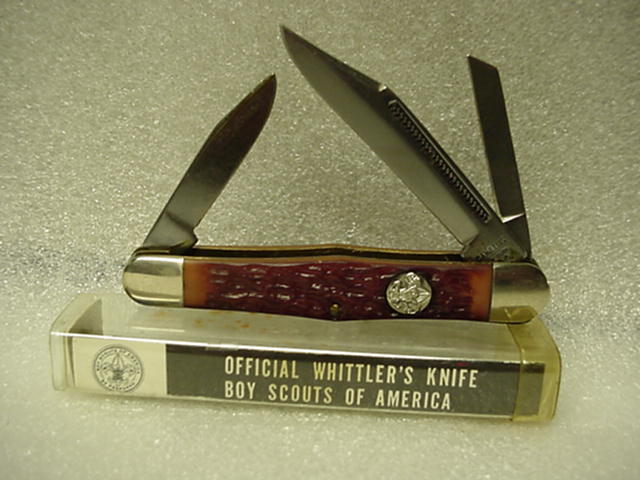 Camillus CAMW3H Scout Knife, New With Box (Photo courtesy Dmitri Pitarys)
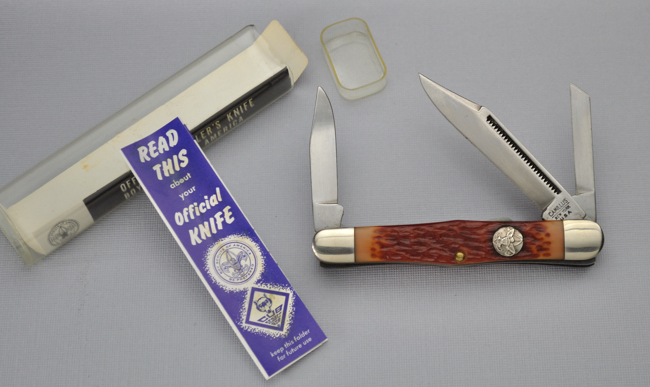 CAMW3H (Knife courtesy of New Mexico Scouting Museum. Photo by Bob Wick.)
CAMW3H (Knife courtesy of New Mexico Scouting Museum. Photo by Bob Wick.) |
|
CAMW3I, BSA #1047. Same as CAMW3E, but with a white handle. Offered 1980-1984. (Same as Kerr CAM16BR, Holbrook W3D)
CAMW3I (Photo courtesy of Jerry Downen) |
| CAMW3J, BSA #1047. Same as CAMW3E, but with Delrin stag handle. Made by Schrade for Camillus. Schrade #863. Manufactured 1987-2007. |
| CAMW3K, BSA #, Camillus #CM-BSA900 The two blade Leader's Classic Knife has a 1 7/8" long high carbon stainless steel clip blade and a pen blade. The brown jigged Delrin handle have an acorn coined nickel silver fleur-de-lis shield, and nickel silver bolsters. Knife length is 2 3/4" closed, and has an open length of 6 1/2". Manufactured (unknown start) - 2007. |
|
CAMW3L, BSA # NA, 75th Anniversary. Three blade, 3.25" length, serpentine shape handle, single rivet bottom center of the handle, non-removable belt shackle, round shield with FDL and eagle, smooth bolsters, brown plastic jigged handles with amber colored ends. Manufactured 1985 only. "75th Anniversary / Boy Scouts of America / 1910 1985" was etched on the main blade, but no emblem on the blade. There were two versions. This one has carbon steel blades, and is the less common of the two varieties. The other version, CAMW3M, has stainless steel blades.
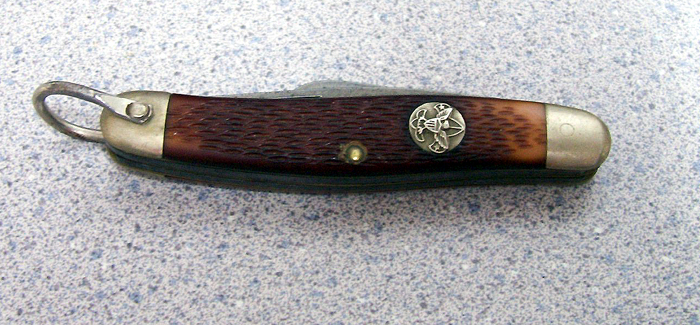 Closed 75th Anniversary Camillus, Serpentine Shape CAMW3L (Allen McBroom)
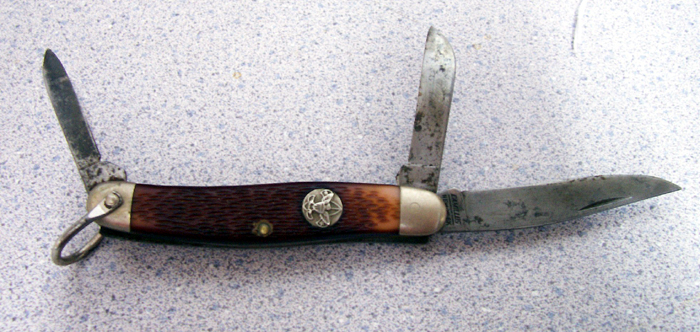 All Three Blades of the CAMW3L; Etching Gone from Main Blade (Allen McBroom)
|
|
CAMW3M, BSA # NA, 75th Anniversary. Identical in every respect to the CAMW3L, except this version has stainless steel blades. This is the most common version of this knife.
CAMW3M, with blade etching visible. Stainless blades. |
Remington
|
Remington Arms Company The Remington Arms Company came to be in 1816. Originally they were called E. Remington and Sons, and changed their name in 1888 to the Remington Arms Company. and began producing cutlery in 1920. Their plant in Bridgeport, Connecticut began producing Boy Scout knives in 1923, and continued making quality BSA knives until their cutlery division was sold to the Pal Blade Company in 1939. Remington-branded BSA knives returned to the market via contract production in 2009. 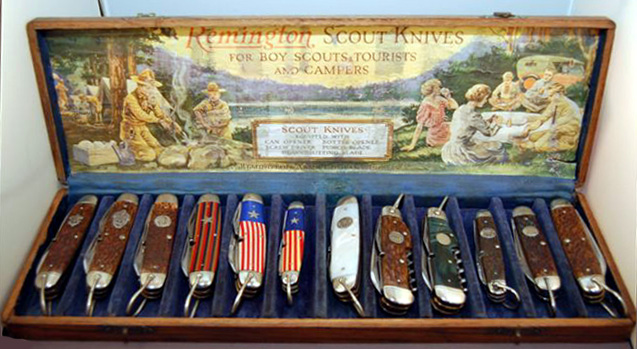
Once upon a time, Remington Scout knives came in this great display box. (Courtesy Mark McClurg) |
|
REMC4A, BSA #1496, Remington #RS3333 The first Remington BSA knife, introduced in 1923. The REMC4A had four blades: a spear with short, thin nail nick, a smooth awl, a one-piece can opener, and a short flat blade screwdriver/cap lifter combo. The bolsters each had a single line, and a permanent shackle was on the end opposite the shield end. The shield was the "acorn" style shield. The can opener had a vertical pull, so there was a notch in the shield side handle to accomodate the vertical pull. This was produced 1923-1924.
REMC4A: Note the acorn shield and lined bolsters. (Courtesy Mark McClurg)
|
|
REMC4B, BSA #1496, Remington #RS3333 Four blade camp knife: Main blade, short flat blade/cap lifter combo, two-piece can opener, and leather awl. Brown bone handle, permanent knife bail on end opposite the shield. Shield is the BSA First Class emblem on an acorn shaped background. There is a notch in the shield side for the vertical can opener pull to fit in. Overall length is 3 3/4". Blade is etched with a horizontal BSA emblem. Manufactured 1924 - 1926.
REMC4B: Well used, shackle is broken off on the left end. |
| REMC4C, BSA #1496, Remington #RS3333 This was the Remington "Award for Heroism" model, presented to those Scouts who received the Awatrd for Heroism. It had the acorn shield, with an additional shield below it, engraved with "The Remongton Award for Herosim". Brown bone handles amd lined bolsters. Produced 1924-1926. |
|
REMC4D, BSA #1497, Remington #RS4233 Four blade camp knife: Long, thin spear blade, smooth awl, one-piece can opener, and a short flat blade screwdriver /cap lifter combo blade. Closed length was 3 3/8", brown bone handles, "pinched" and lined bolsters. Permanent shackle on the end opposite the acorn shield. Produced 1923-1924. 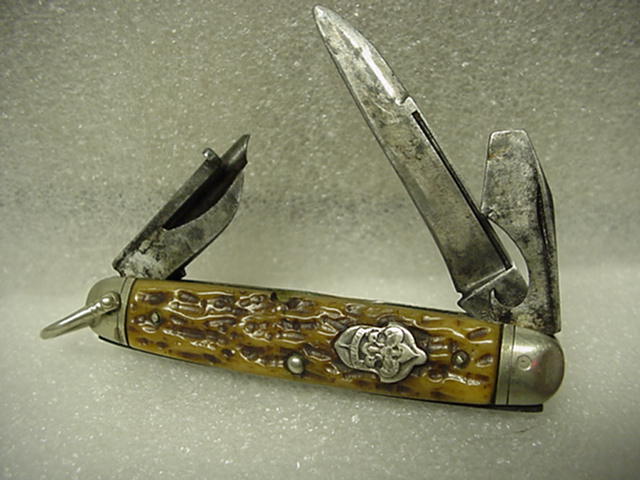 REMC4D: Note one piece can opener. (Courtesy Dimitri Pitarys)
|
|
REMC4E, BSA #1497, Remington #RS4233 Four blade camp knife: Long, thin spear blade, two-piece can opener, smooth awl, and short flat blade screwdriver/cap lifter combo blade. Lined, pinched bolsters. Permanent shackle on end opposite acorn shield. Brown bone handles, closed length 3 3/8". Manufactured 1924-1926. |
|
REMC4F, BSA #1496, Remington #RS3333 Four blade camp knife: Main blade, long flat blade/cap lifter combo, two-piece can opener, leather awl. Shield is First Class emblem with no acorn background. Main blade has ashort nail pull. Brown bone handles, permanent shackle opposite shield end. One line on each bolster. Note the concave indentation at the base of the cap lifter. Overall length is 3 3/4". Manufactured in 1927. REMC4F: The blade etch is horizontal, not vertical. (Courtesy Mark McClurg) |
|
REMC4G, BSA #1496, Remington #RS3333 Four blade camp knife: Fat spear blade with short nail nick, short can opener/cap lifter combo, smooth awl, two-piece can opener. Vertical can opener lift tab, so there's a notch on the shield side handle to accomodate the tab. Round shield, brown bone handles, lined bolsters. Permanent shackle on end opposite the shield end. Closed length 3 3/4". Produced 1929-1932. |
|
Remington "one piece" can openers were made from one stamped piece of steel, as shown in the example on the left. The "two piece" opener shows a joint where the two stamped pieces go together. |
| REMC4H, BSA #1496, Remington #RS3333 Back spring is exposed, as are most Remongton Scout knives. Four blade camp knife: Fat spear blade with short nail nick, long can opener/cap lifter combo, smooth awl, two-piece can opener. Horizontal can opener lift tab. Round shield, brown bone handles, lined bolsters. Permanent shackle on end opposite the shield end. Closed length 3 3/4". Produced 1933-1935. |
|
REMC4I, BSA #1496, Remington #RS3333 Four blade camp knife, brown bone handles, smooth bolsters, non-removable bail on end opposite the shield end. Overall length 3 3/4". Note the shield side handle has no notch for a can opener pull, as the pull is parallel to the length of the handle. Manufactured 1933-1939.
REMC4I: Note the parallel pull tab for the can opener
REMC4I: The slightly shorter screwdriver differs from the longer RECC4H screwdriver
REMC4I: A nice example showing the horizontal blade etch. (Courtesy Mark McClurg)
Closeup of round shield with good detail.
Nice Remington REMC4I camp knife, 1933-1939 (Courtesy Max Reyes)
REMC4I: Bone handles can be several different colors inside the same model. (Knife courtesy of New Mexico Scouting Museum. Photo by Bob Wick.) |
| REMC4J, BSA #1496, Remington #RS3333 Back spring is covered by a metal plate. Four blade camp knife: Fat spear blade with short nail nick, long can opener/cap lifter combo, smooth awl, two-piece can opener. Horizontal can opener lift tab. Round shield, brown bone handles, lined bolsters. Permanent shackle on end opposite the shield end. Closed length 3 3/4". Produced 1933-1935. |
|
REMC4K, BSA #1496, Remington #RS3333 This is a beautiful knife. Four blade camp knife: Main blade, long flat blade/cap lifter combo, awl, and two-piece can opener. Since the can opener has a horizontal pull, there is no need for a pull notch in the handle. Smooth bolsters, permanent shackle, and round shield with the BSA First Class emblem. White pearl handles. Manufactured 1933-1935. 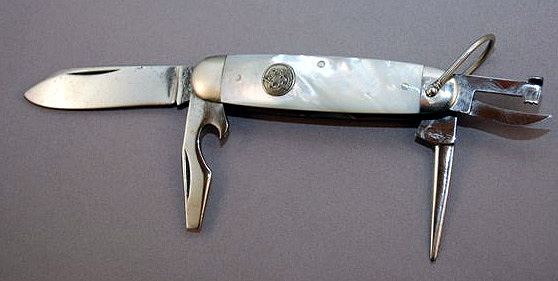 |
|
REMC4L, BSA #1497, Remington #RS4233 Four blade camp knife: Skinny main blade, long flat blade/cap lifter combo with convex bulge at base, and two-piece can opener. Permanent shackle on end opposite the shield. Can opener has a vertical pull, so there is a notch for the pull in the shield side of the bone handle. This has pinched bolsters,s which means there is a "dimple" on the extreme end of each bolster. Each bolster has a single line. Main blade has a long nail pull. Manufactured 1929-1932. 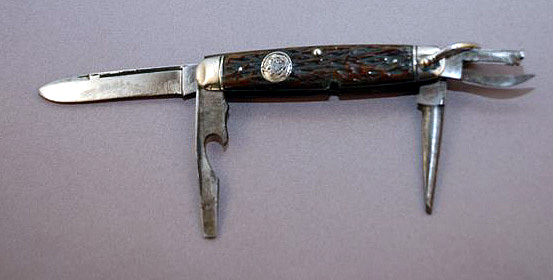 REMC4L: Skinny main blade, long screwdriver, round shield. (Courtesy Mark McClurg)
|
| REMC4M, BSA #1497, Remington #RS4233 Four blade camp knife: Long, skinny spear blade with long nail nick, two-piece can opener with horizontal pull tab, smooth awl, long flat bade screwdriver/cap lifter combo. Round shield, brown bone handles, permanent shackle on end opposite shield. Manufactured 1933-1939. |
|
REMC4N, BSA #19860 , Remington Pattern #RS3333 This is a 2009 reproduction of the original RS3333 knife, REMC4B. Remington contracted with Bear and Sons in Jacksonville, AL to reproduce this knife using the original 1920's Remington toolings. The tang bears the same original "Remington UMC" stamp, but the other side of the tang is deeply stamped "2009" to distinguish the original knives from the new production models. Manufactured in 2009 only. Suggested retail is $99.99.
2009 Issue RS3333 Scout Knife (Courtesy Remington Arms) 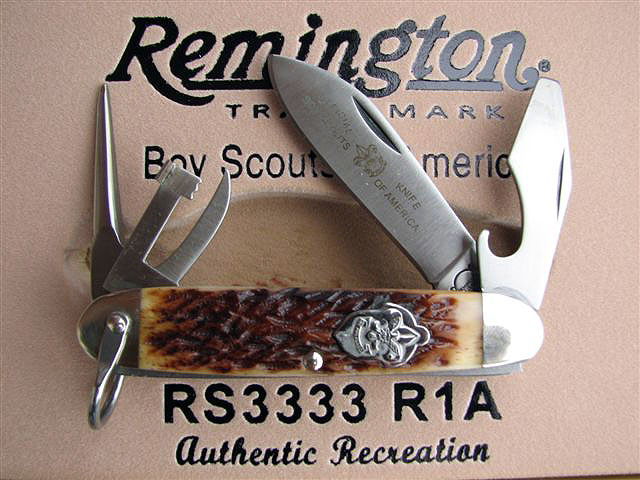 REMC4N, 2009 Replica of RS3333 (Photo courtesy Phil Stevens)
|
| REMC3A, BSA #N/A, Remington #RS4773 Three blade camp knife: Long spear with long nail nick, long can opener/flat blade screwdriver combo, two-piece can opener. No shackle. Round shield, brown bone handles, 3 3/8" long when closed. Smooth bolsters. Manufactured 1928-1932. |
| REMC3B, BSA #1494, Remington #RS4783 Three blade camp knife: Long spear with long nail nick, long can opener/flat blade screwdriver combo, two-piece can opener. Smooth bolsters, round shield, removable shackle on end opposite shield. Brown bone handles. Produced 1934-1939. |
|
REMC3C, BSA #1494, Remington #RS4783 Three blade camp knife: Fat main blade with long nail pull, can opener, and combo long flat blade/cap lifter. Bone handles, round shield, removable shackle on end opposite the shield end. Overall length is 3 1/2". Manufactured 1934-1939. 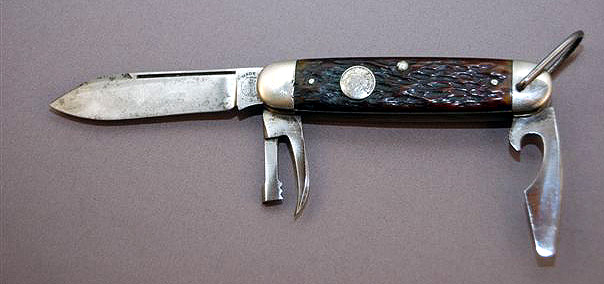 REMC3C: Round shield, only three blades, removable shackle. (Courtesy Mark McClurg) |
| REMF1A, BSA #1559, Remington #RH50. Fixed blade sheath knife, no finger grooves on handle. Curved blade is 4 1/2"long, overall length is 8 1/2". Handle is made of stacked leather and colored fiber washers. Nickel silver thumb guard, cast aluminum end cap. Came with an oak tanned leather sheath, sewn edges with seven rivets. Sheath and knife both embossed with the BSA emblem. These weighed about 8 oz each. In 1938, the wholesale price for these knives was $30 per dozen ($2.50 each). Retail was probably double that amount. Manufactured 1933-1939.
1938 Wholesale Catalog Advertisement (REMF1A Shown)
REMF1A (RH50) without sheath. Note the blade etching and curved blade. |
| RWMF1B, BSA #1559, Remington #RH50. Same as REMF1A, but with finger grooves on handle. |
|
REMF1C, BSA #1561, Remington #RH51. Same as REMF1A (no finger grooves), but with straight blade instead of curved, and blade length is 4", overall length is 8". Each knife and sheath pair weighed about 5.6 oz. Wholesale price in 1938 was $31.60 per dozen ($1.80 each), retail was probably double that figure. Manufactured 1933-1939.
REMF1C: No finger grooves, straight blade. (Courtesy Dimitri Pitarys) |
|
REMF1D, BSA #1561, Remington #RH51. Same as REMF1C, but with finger grooves in the handle.
REMF1D with sheath. Note the finger grooves and straight blade.Blade etching has worn away.
Closeup of sheath stamp on REMF1D sheath. Bottom line read "National Council New York City".
Close-up of RH-51 stamp on tang of the REMF1D fixed blade. |

